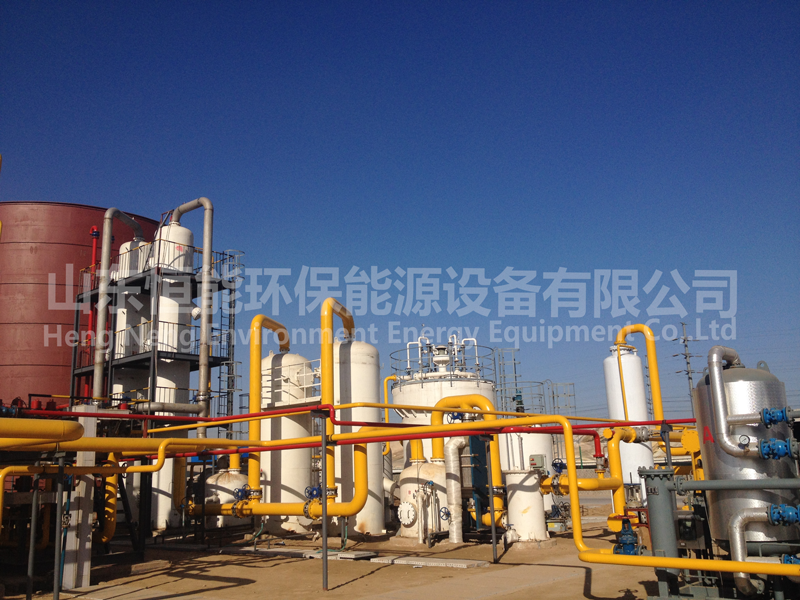歡迎進入山東恒能環保能源設備有限公司
歡迎進入山東恒能環保能源設備有限公司
沼氣屬可再生能源,主要含甲烷(40% - 70%)、二氧化碳(15% - 60%)及少量硫化氫等雜質。提純后可得高純度生物甲烷(CH?>97%,CO?<3%),具清潔、高效等特性,在車用能源、化工等領域應用廣,利于改善能源結構、緩解能源危機及減少污染。主流提純技術有吸收法、變壓吸附法、低溫冷凝法與膜分離法。?
Biogas is a renewable energy source, mainly containing methane (40% -70%), carbon dioxide (15% -60%), and a small amount of impurities such as hydrogen sulfide. After purification, high-purity biomethane (CH ?>97%, CO ?<3%) can be obtained, which has the characteristics of cleanliness and high efficiency. It is widely used in automotive energy, chemical industry and other fields, which is conducive to improving energy structure, alleviating energy crisis and reducing pollution. The mainstream purification technologies include absorption, pressure swing adsorption, low-temperature condensation, and membrane separation. ?
吸收法:分物理、化學吸收。?
Absorption method: divided into physical and chemical absorption. ?
壓力水洗技術:利用 CO?在水中溶解度遠超 CH?(約 25 倍),在高壓低溫下脫除沼氣中 CO?。如二段式吸收塔,能提升 CO?吸收效果,降低吸收液用量。該技術以水為吸收劑,成本低、環保,工藝穩定,提純后甲烷含量可達 97%,能滿足車用壓縮天然氣要求。?
Pressure water washing technology: Utilizing the solubility of CO ? in water far exceeding that of CH ? (about 25 times), CO ? is removed from biogas under high pressure and low temperature. Like a two-stage absorption tower, it can improve the absorption efficiency of CO ? and reduce the amount of absorption liquid used. This technology uses water as an absorbent, with low cost, environmental friendliness, and stable process. After purification, the methane content can reach 97%, which can meet the requirements of compressed natural gas for vehicles. ?
有機胺吸收技術:借助有機胺溶液與二氧化碳的物理化學吸收特性提純。在吸收塔加壓常溫時,有機胺溶液吸收二氧化碳脫碳提純甲烷;吸收富液在再生塔減壓加熱時逆向解析,釋放高純度二氧化碳并再生,實現連續脫碳與吸收液循環。此技術吸收效果好,但吸收劑再生能耗高,對裝備防腐要求高。?
Organic amine absorption technology: Purification by utilizing the physical and chemical absorption characteristics of organic amine solutions and carbon dioxide. When the absorption tower is pressurized at room temperature, the organic amine solution absorbs carbon dioxide for decarbonization and purification of methane; During the depressurization heating of the regeneration tower, the rich solution is reverse analyzed to release high-purity carbon dioxide and regenerate it, achieving continuous decarbonization and absorption liquid circulation. This technology has good absorption effect, but the regeneration energy consumption of the absorbent is high, and it requires high equipment anti-corrosion requirements. ?
變壓吸附法:利用吸附劑(如分子篩)對二氧化碳的選擇性吸附,在加壓時二氧化碳被吸附在塔內,甲烷等弱吸附氣體排出;吸附飽和后減壓或抽真空釋放二氧化碳。至少需兩個吸附塔以保證連續處理。該技術提純效率較高,但投資、操作費用高,CH?損失大。?
Pressure swing adsorption method: using adsorbents (such as molecular sieves) for selective adsorption of carbon dioxide, carbon dioxide is adsorbed in the tower under pressure, and weakly adsorbed gases such as methane are discharged; Release carbon dioxide by depressurizing or vacuuming after adsorption saturation. At least two adsorption towers are required to ensure continuous processing. This technology has a high purification efficiency, but it incurs high investment and operating costs, resulting in significant CH ? losses. ?

低溫冷凝法:因二氧化碳液化溫度高,經低溫使其液化,甲烷作為不凝氣排出。常采用回熱技術回收冷量。不過,因技術成熟度與經濟性問題,目前在沼氣提純工程中應用少,其運行能耗高、設備投資大,操作條件苛刻。?
Low temperature condensation method: Due to the high liquefaction temperature of carbon dioxide, it is liquefied at low temperature, and methane is discharged as non condensable gas. Regenerative technology is often used to recover cooling capacity. However, due to technological maturity and economic issues, it is currently rarely used in biogas purification projects, with high operating energy consumption, large equipment investment, and harsh operating conditions. ?
膜分離法:基于不同氣體組分在壓力下通過膜的滲透性差異提純,CO?滲透快為透過氣排出,CH?滲透慢以透余氣獲提純產品氣,工程中常采用多級膜分離工藝。?
Membrane separation method: Purification is based on the differential permeability of different gas components through the membrane under pressure. CO ? permeates quickly as the permeate gas is discharged, while CH ? permeates slowly as the permeate gas to obtain purified product gas. Multi stage membrane separation process is commonly used in engineering. ?
優勢:膜分離無化學反應與相變,能耗低,適合中小規模沼氣提純,運行成本低于傳統方法。系統模塊化,可依處理量調整膜組件數量,占地小,易安裝擴容。無移動部件,自動化程度高,穩定性強,維護成本低,無化學試劑消耗,不產生二次污染,可回收低純度 CO?,系統啟停快,適合間歇性項目。?
Advantages: Membrane separation has no chemical reactions or phase changes, low energy consumption, suitable for small and medium-sized biogas purification, and lower operating costs than traditional methods. The system is modular, and the number of membrane components can be adjusted according to the processing capacity. It occupies a small area and is easy to install and expand. No moving parts, high degree of automation, strong stability, low maintenance cost, no chemical reagent consumption, no secondary pollution, can recover low purity CO ?, fast system start stop, suitable for intermittent projects. ?
局限:高性能膜多依賴進口,成本高,初期投資大。膜易污染、老化,需定期更換,長期成本增加。H?S、水蒸氣等雜質會影響膜性能,需預處理,顆粒物易堵塞膜孔,需嚴格過濾。單級膜分離甲烷回收率低,需多級串聯或與其他技術結合提高回收率,且難直接達高純度,可能需二次提純,CO?滲透側甲烷殘留處理復雜。?
Limitations: High performance membranes rely heavily on imports, have high costs, and require significant initial investment. The membrane is prone to contamination and aging, requiring regular replacement, which increases long-term costs. Impurities such as H ? S and water vapor can affect membrane performance and require pretreatment. Particulate matter can easily clog membrane pores and requires strict filtration. The single-stage membrane separation of methane has a low recovery rate and requires multi-stage series connection or combination with other technologies to improve the recovery rate. It is also difficult to directly achieve high purity and may require secondary purification. The residual treatment of methane on the CO ? permeation side is complex. ?
總之,不同沼氣提純工藝各有優劣。實際應用中,要綜合原料沼氣成分、規模、投資預算、產品純度要求、運行成本及維護管理等因素,選擇最適宜技術,實現沼氣高效、經濟利用。如中小規模且對能耗敏感、原料氣雜質少的項目,膜分離法較合適;大規模、對產品純度要求極高的項目,可能需多種技術聯用
In short, different biogas purification processes have their own advantages and disadvantages. In practical applications, it is necessary to comprehensively consider factors such as the composition, scale, investment budget, product purity requirements, operating costs, and maintenance management of raw biogas, and select the most suitable technology to achieve efficient and economical utilization of biogas. For small and medium-sized projects that are sensitive to energy consumption and have low impurities in the feed gas, membrane separation is more suitable; Large scale projects with extremely high requirements for product purity may require the combination of multiple technologies
本文由沼氣提純友情奉獻.更多有關的知識請點擊:http://m.chinaktws.com我們將會對您提出的疑問進行詳細的解答,歡迎您登錄網站留言.
This article is dedicated to friendship For more information, please click: We will provide detailed answers to your questions. You are welcome to log in to our website and leave a message